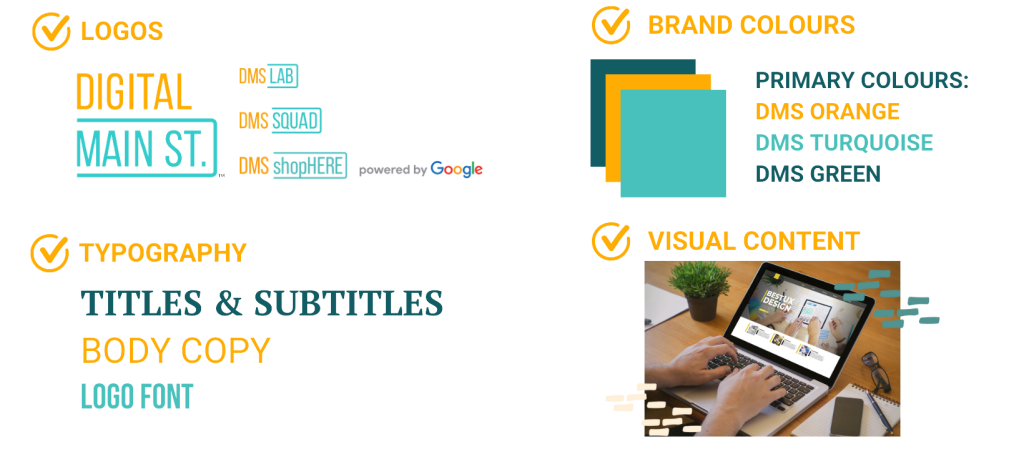
Getting E-Commerce Ready: Building Your Brand
Unveiling the Power of Brand Stories, Mission Statements, and Buyer Personas
In the ever-evolving small business landscape, establishing a strong and memorable brand is essential for success. Beyond logos and colour schemes, the heart of a brand lies in its narrative—the story it tells, the mission it upholds, and the deep understanding it has of its target audience.
In this blog post, we'll delve into the crucial components of effective branding: the importance of business brand stories, creating a mission and value statement, understanding buyer personas and demographics, and overall branding best practices.
The Power of Business Brand Stories
In a world inundated with information, stories stand out. They create connections, evoke emotions, and leave a lasting impression. Your brand story is more than a chronicle of your company's history—it's a powerful tool for forging a bond with your audience. A compelling brand story communicates your values, aspirations, and the unique journey that sets your business apart. Whether it's overcoming challenges, innovating in your industry, or championing a cause, sharing your story humanizes your brand, making it relatable and memorable.

When sharing your brand story, authenticity is key. People connect with genuine narratives, so be transparent about your values, successes, and even setbacks. The more authentic and relatable your story, the more likely it is to resonate with your audience. To develop your brand story, describe how your business transformed into what it is today.
- When did you start your business, and why?
- What does your business value?
- What makes your business unique?
- What problem does your business or product solve?
Your brand story gives your customers an inside look at your business and what you have to offer. The content that you create can be influenced by your brand story and set the tone in which you speak to your audience. Communicating your brand story can be done in various ways including:
- An ‘About Us’ section on your e-commerce site
- Blog
- E-Newsletters
- Médias sociaux
Creating a Mission and Value Statement
A mission or value statement is the compass that guides your business and articulates the principles that underpin your company's culture and decision-making. It encapsulates your brand story, purpose, goals, and the impact you aim to make on the world.
Mission statements help you identify the products and offerings that will lead to your customers relating to, and connecting with your business, while a value statement is a set of ideals that explain what your company believes in and how it operates. Together, these statements serve as a roadmap for your brand, guiding customers and partners.
When formulating your mission and value statements, consider the following questions:
- What is the core purpose of your business?
- What values does your company embody?
- How do you envision contributing to your community or industry?
Case Study Example: Flow State Bike Co.
Flow State Bike Co. outlines their mission and value statement directly on their website. By sharing this with their customers they can understand their purpose and values, and align with them on their authentic brand story and goals. As their mission states, Flow State Bike Co. aims to redefine what a bike shop can be and creates a space for cyclists to gather as a community. They bring this mission statement to life through their online store and physical business space. Using their mission statement, Flow State Bike Co. shaped their product offerings by not only providing a full-service bike shop but also offering a meeting space for like-minded cyclists to enjoy a snack in their licensed coffee bar. Flow State Bike Co.’s “Coffee Stop For Cycling Groups” also offers reservations where cyclists can pre-book a visit in their space. By clearly defining your mission and values, you not only provide a sense of direction for your team but also offer transparency to your customers, helping them align with a brand that shares their values. Utilize your e-commerce presence to share your business’s mission to help you connect with the right customers. |
Understanding Buyer Personas and Buyer’s Journey
Buyer Personas
To resonate with your audience, you must first understand them. Enter buyer personas—a fictional representation of your ideal customer based on research and data. Understanding your target audience's demographics, behaviours, and preferences allows you to tailor your brand messaging, products, and customer experiences to their specific needs.
By distinguishing the demographics and behaviours of your audience, you can pinpoint the platforms they frequent, whether it be social media, email, or traditional advertising. Moreover, recognizing their preferences enables you to tailor the content of your messages to resonate with their values and interests, thus increasing engagement. Timing your messages to coincide with peak engagement periods or key decision-making moments ensures maximum impact.
Following the formation of your buyer personas, you must also consider how your customers will interact with you and how they will be introduced to your business, including how customers will discover, research and purchase your products or services. This is called the buyer’s journey – the process that potential customers go through before making a purchase.
Consider conducting surveys, analyzing customer feedback, and utilizing analytics tools to gather insights into your audience. With this information, you can create detailed buyer personas that encompass not only demographic details but also psychographic elements like interests, values, and lifestyle choices. By understanding your audience on a deeper level, you can speak directly to their needs and establish a more meaningful connection.
Buyer's Journey
Understanding the buyer's journey is crucial for your business as it helps you tailor your marketing efforts and content to effectively engage with potential customers at each stage of their journey. By optimizing this process you will ultimately lead to higher conversion rates and increased customer satisfaction.
Your buyer's journey typically consists of four main stages: awareness, consideration, interest and acquisition.

In the awareness stage, customers become aware of a problem or need they have and start researching potential solutions. By sharing content on social media, you can display how your products or services can fill this need.
During the consideration stage, customers evaluate different options available to them, weighing factors like features, benefits, and cost. In this stage, having a well-laid-out product or service page that highlights these factors can display the advantage of transacting with your business over your competitors.
In the interest stage, customers make a purchase decision based on their research and evaluation. The interest stage can be where potential consumers are making their final decision on purchasing your product. To incentivize this sale, consider leveraging re-engagement strategies like abandoned cart checkout emails or sending a coupon code with links to your website guiding them into the final buyer's journey stage.
Upon deciding to purchase your product or service, customers enter the final acquisition stage where they navigate through your online store to complete their purchase. Having a seamless checkout experience or lower shipping rates will increase the likelihood of a customer making a purchase and completing the final step in the buyer’s journey.
Overall Branding Best Practices
Branding best practices encompass a strategic approach to creating and maintaining a distinct identity for a business or product. Consistency is key- a memorable and visually appealing logo, accompanied by a cohesive colour palette and typography, enhances brand recognition.

Establishing a unique brand voice and tone across all communication channels, including marketing materials and social media, fosters a genuine connection with consumers. Building a consistent brand experience requires attention to detail, ensuring that every touchpoint reinforces the brand's narrative.
- Consistency is Key: Maintain a cohesive brand image across all platforms, from your website and social media to packaging and customer interactions. Consistency builds trust and reinforces brand recognition.
- Adapt to Trends, but Stay True to Your Core: While it's essential to stay current, avoid chasing trends at the expense of your brand's identity. Evolve strategically, ensuring that changes align with your mission and values.
- Engage and Listen: Actively engage with your audience on social media, respond to feedback, and listen to their concerns. This not only fosters a sense of community but also provides valuable insights for refining your brand strategy.
Key Takeaways
The journey to building a powerful brand involves weaving a compelling narrative, defining a clear mission, understanding your audience, and embracing best practices. By combining these elements, you create a brand that stands out in a crowded market and resonates with your audience on a deeper level. As you embark on this branding adventure, remember that a strong brand is not just a logo—it's a story waiting to be told, a mission waiting to be fulfilled, and a connection waiting to be forged.
- Brand Stories – Your brand's story is the DNA of your business- it reflects all you are and all you do! Your story tells your business's history, purpose and future goals. All the small details that explain who you are and why your business is unique helps customers understand why they should choose your business to support. In a marketplace where choices are plentiful, consumers don't just buy products; they invest in the values, the journey, and the intention behind a business. A well-crafted brand story guides consumers through their options and offers authenticity and relatability.
- Mission and Value Statements – Crafting a mission statement is like setting the compass for your organization’s journey. A compelling mission statement becomes a powerful tool for brand positioning. It communicates your values to customers, partners, and the broader community, displaying a direction that goes beyond products or services, but instead explains your business’s future goals. Utilize your online and E-Commerce presence to share your business’s vision with your customers, and allow them to connect with your values and goals.
- Buyer Personas – Developing buyer personas is the key to building strong connections with your customers. This strategy ensures you’ll have deep insight into how you target your demographic, what content to create and what products to offer. Buyer personas are not static entities; they evolve with your business and the market. To get started, use your online store as a data-collecting tool to learn more about your customers, their interests and behaviours.
- Branding Best Practices – Crafting a compelling brand identity and understanding the nuances of business branding best practices helps lead you to success in the online world. It’s not just about standing out; it’s about leaving your mark in the minds of your audience. Make your online store the place to go for your product or service by creating memorable content that demonstrates your business's core values and unique personality.
To learn more about digital transformation and e-commerce, check out our virtual events tailored for small businesses.

